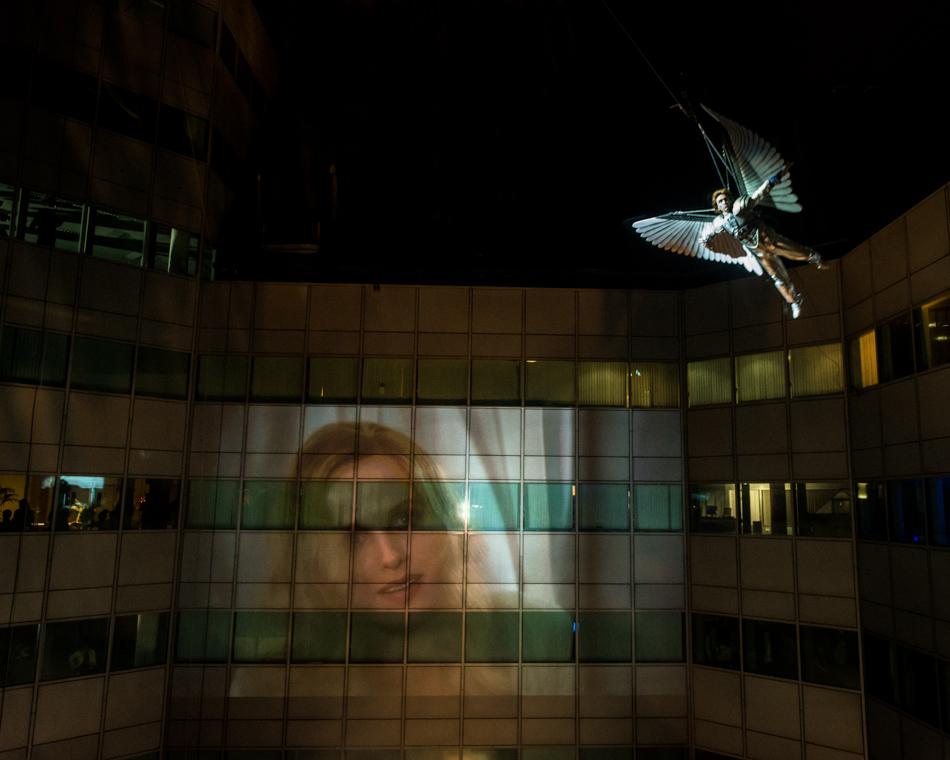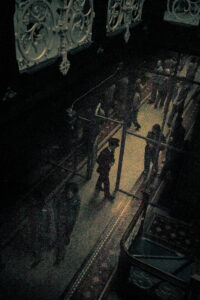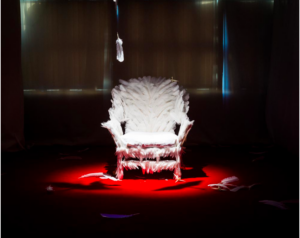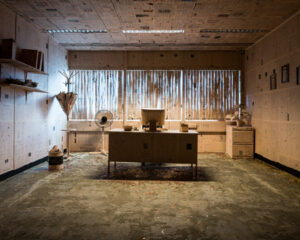
By Eftihia Stefanidi, Creative Director and Photographer, Co-founder at Mona Athens and Shila Athens
A cinematic take on how quotidian architectures become the centrepiece of a groundbreaking immersive experience
“Architecture exists, like cinema, in the dimension of time and movement. One conceives and reads a building in terms of sequences. To erect a building is to predict and seek effects of contrast and linkage through which one passes…”_ Jean Nouvel
When Secret Cinema launched in London more than ten years ago as an underground, site-specific screening club, a new genre in cinema-going was born. The premise was a little unusual: the audience would buy a ticket to a screening in which the location and the title of the film were not revealed till the day of performance. In the chosen location, which was often a disused site, a film would come to life via the transformation of the site into a detailed mise-en-scène, where actors performed scenes in parallel to the narrative of the movie. The audience, having been preassigned a character and a specific dress code, would be invited to explore a fantastical universe while interacting with fellow punters, blurring the line between fiction and reality. These immersive experiences preceded the screening, and served as both the warm up and the crescendo till the actual viewing of the film.

Secret Cinema presents The Shawshank Redemption, by ©Hanson Leather
For instance, during the staging of The Shawshank Redemption, the audience were summoned to court and eventually thrown in jail—an old disused school turned into a prison set. During the process, they were also stripped off their clothes and belongings and left navigating their cells in grey overalls. For Terry Gilliam’s dystopian Brazil, they arrived in the middle of nowhere in London, dressed as white collar workers, making their way through labyrinthine bureaucratic spaces, in a thirteen storied decrepit office building. When Terry Gilliam himself attended the show as a guest and inadvertently got trapped in a malfunctioning lift, he amusingly treated it as part of the show, signalling to the failure of a complacent ‘system’ in society vis-à-vis the unpredictability of humanity.
This consummate world of Secret Cinema was created with meticulous attention to detail and an unrestrained imagination. The zeitgeist of the experience was obviously the cinematic thread, however the protagonist was the site itself.
Throughout my time with the troupe, what I treasured most was our insatiable appetite for scouting these venues. We would look everywhere, and at everything that offered us the possibility of scale, clandestine symbolisms and also a sense of history. From vacant mental hospitals (One Flew Over the Cuckoo’s Nest) to forgotten Town Halls (Miller’s Crossing);iconic Victorian buildings (Lawrence of Arabia), to old newspaper printing presses (Star Wars) we would work around the clock to secure them. These sets took months to plan and build, engaging hundreds of cast and crew, but the show itself had a run of a mere four to eight weeks, adding a heightened temporality to the experience. The unspecified nature and context of these undertakings often left local councils and landlords in a bind, and it required extraordinary powers of persuasion to acquire permissions.

Secret Cinema presents Brazil, ©Photo Alastair Philip Wiper
Secret Cinema’s locations would not only shape the production and performance design, but also, a lot of the time dictated the choice of the film itself. These venues offered up a parallel reality, which each of us lived and breathed as if it was our real lives, akin to method acting. We roamed the set, quoting lines from Casablanca or The Red Shoes being both creators and participants at once.
It is only through the reflective distance of time that I have grasped the extent of how much the spatiality of architectural processes influence and engineer our imagination. It was a privilege to be given the opportunity to renegotiate and reimagine these spaces which were built for purposes entirely different. We would often think about our audience rediscovering these neglected sites, in space and time, and what it might mean to them. They could be walking past these places in their day-to-day and have possibly never considered them as part of their lived experience. Once the show was over, these sites would simply go back to their functionless form, destined to be demolished and turned into nightclubs and apartment buildings.

Secret Cinema presents Brazil, ©Photo Alastair Philip Wiper
This kind of repurposing of architecture holds new meaning and writes itself into the DNA of the space, as it opens itself up for a rich interpretation of time and space. Layers upon layers activated and peeled off at once, enhancing their new materiality where the banal was seen under a different light. These augmented experiences shared collectively and uncannily made for an intimate space of belonging.
In retrospect, the makers and the audience together were privy to this magnificent dialogue between design and architecture, manifesting in a fleeting yet momentous cinematic experience. It is this rapture that flowed and moved us, making such happenings, hyper-real and alive for all us involved.
.
.
.